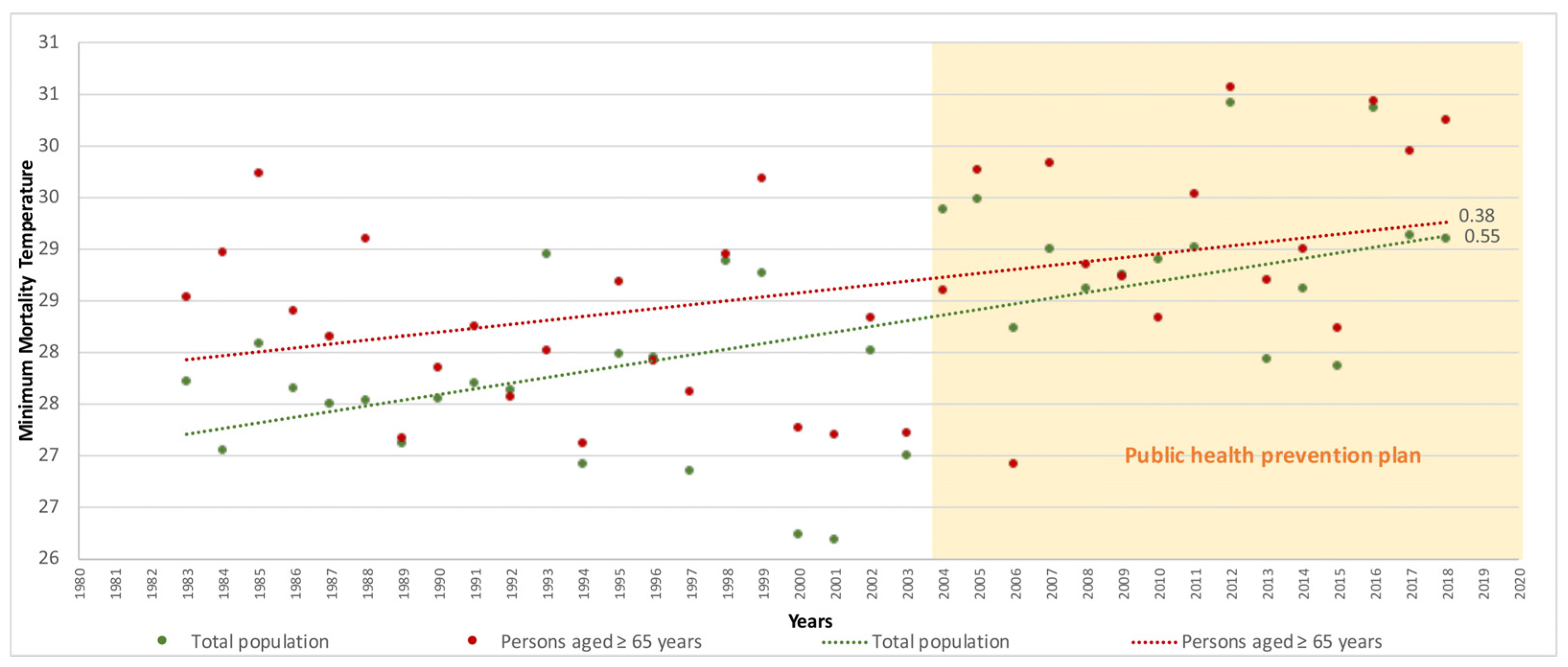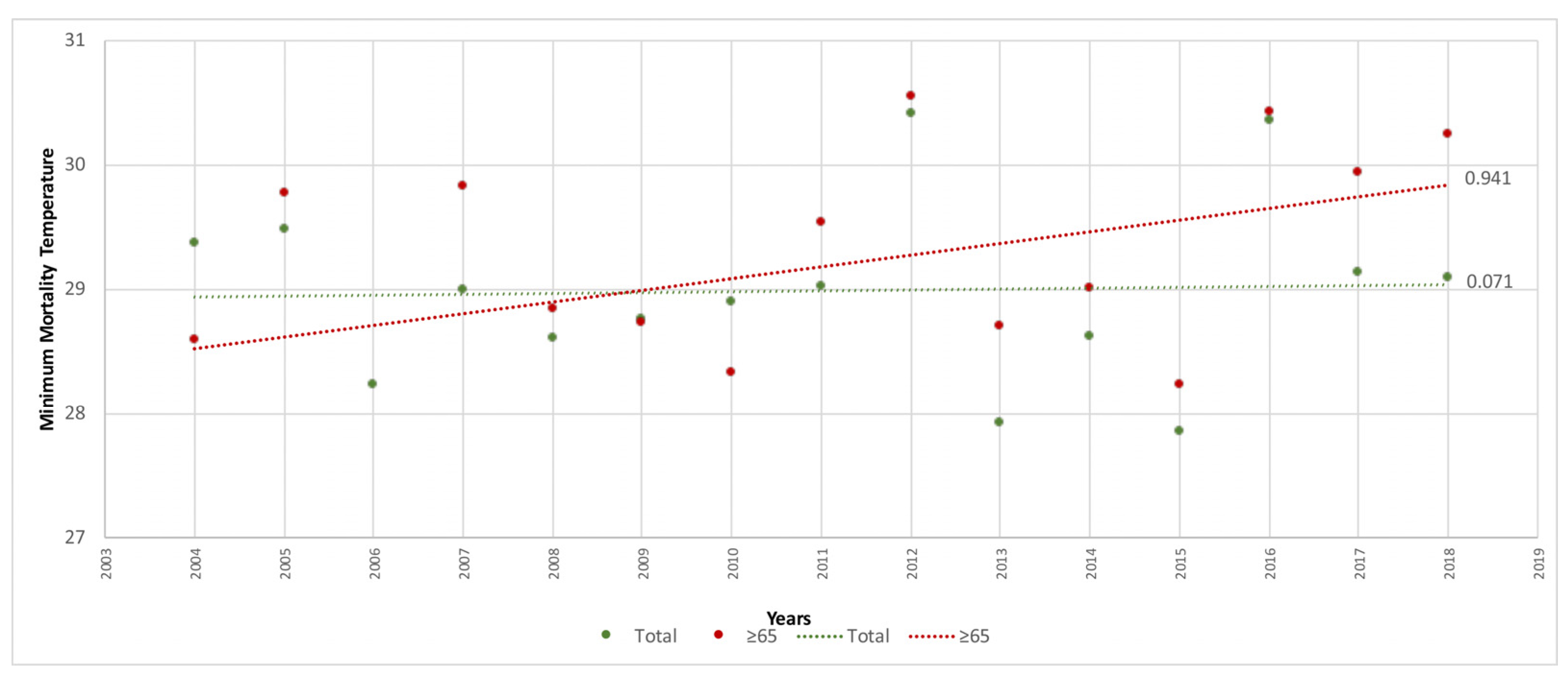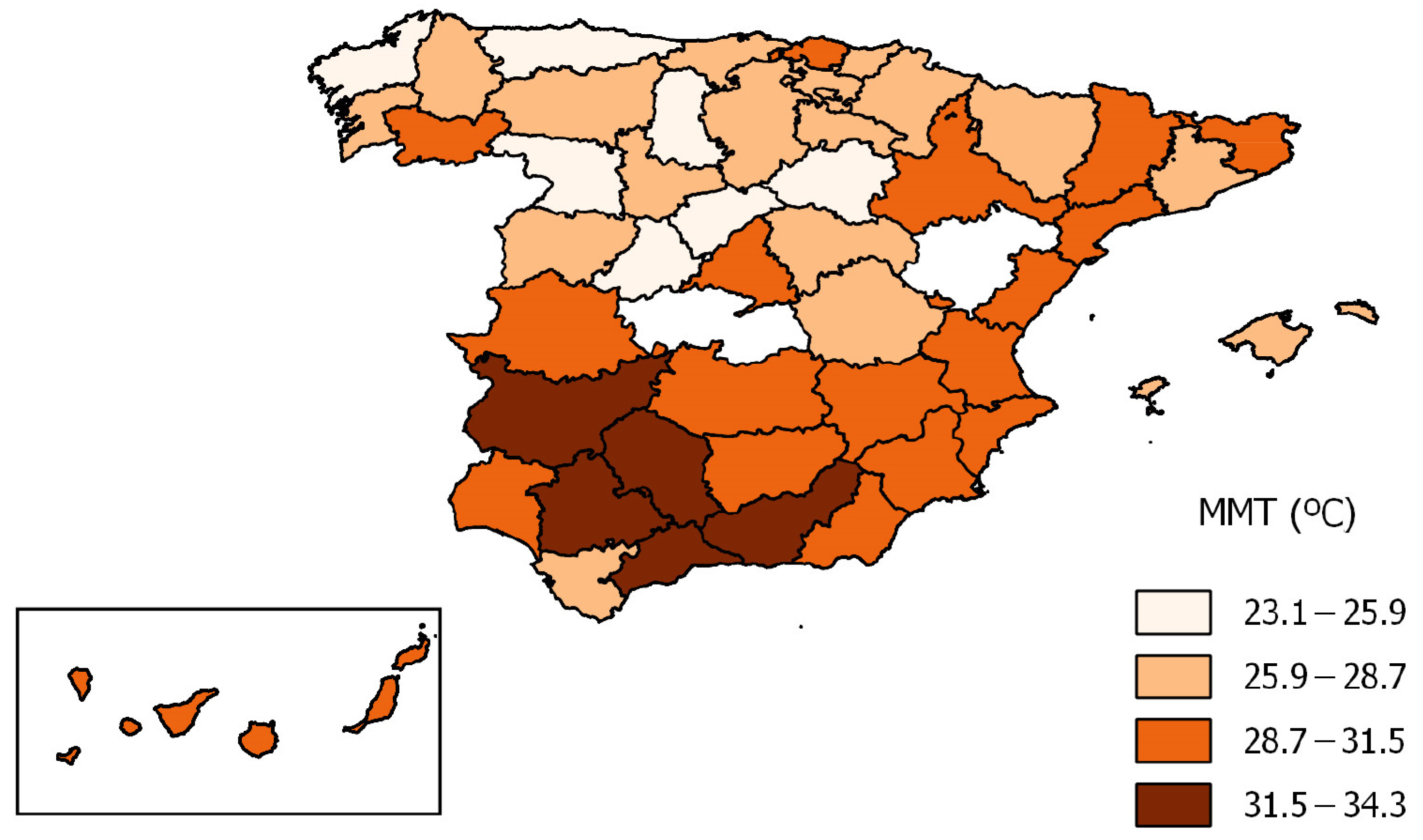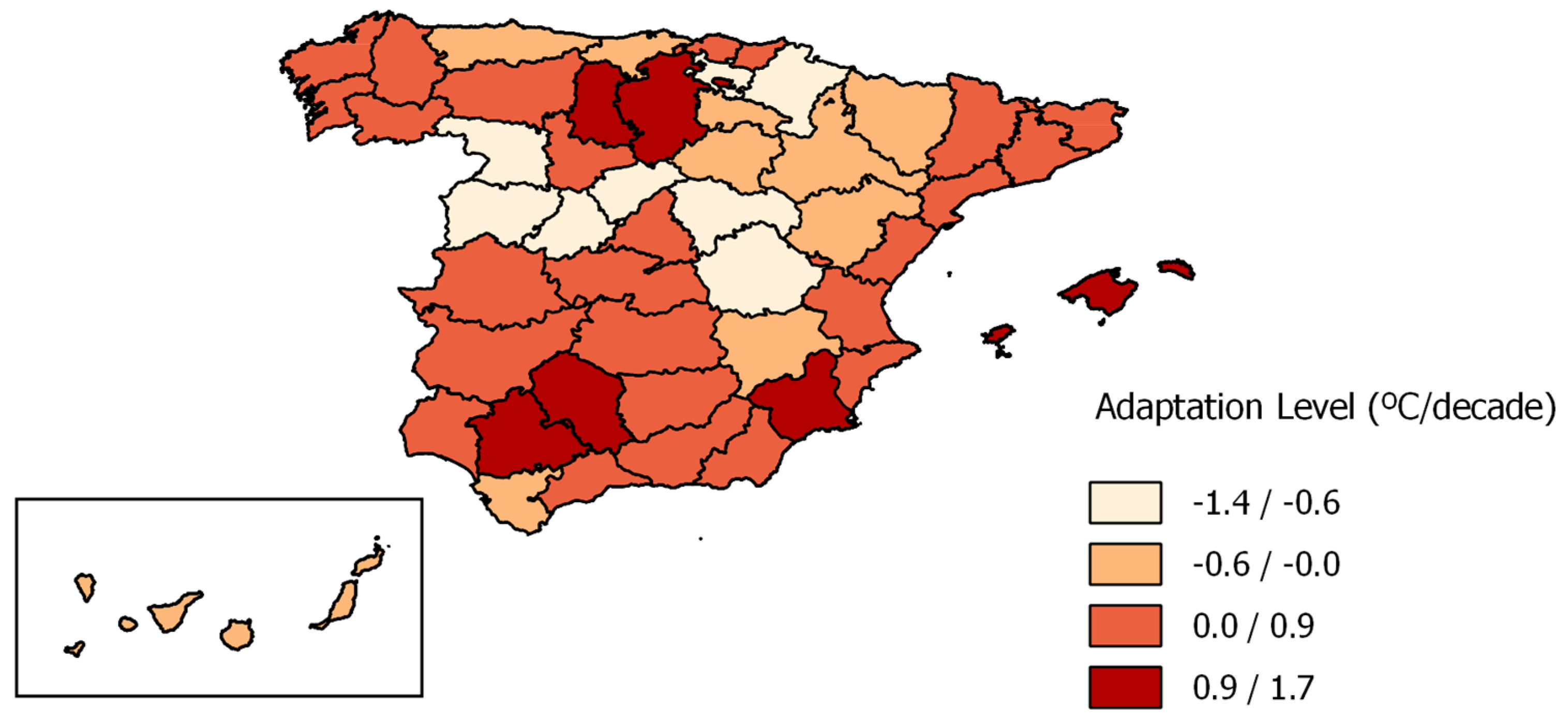Heat Adaptation among the Elderly in Spain (1983–2018)
Abstract
:1. Introduction
2. Materials and Methods
2.1. Calculation of MMT
2.2. Determination of Heat Adaptation Levels
2.3. Data Analysis
3. Results
4. Discussion
4.1. Vulnerability to Heat in the Elderly
4.2. Adaptation to Heat in the Elderly Population
5. Limitations
6. Conclusions
Author Contributions
Funding
Institutional Review Board Statement
Informed Consent Statement
Data Availability Statement
Acknowledgments
Conflicts of Interest
References
- IPCC Climate Change 2022: Impacts, Adaptation and Vulnerability—IPCC. 2022. Available online: https://www.ipcc.ch/report/ar6/wg2/ (accessed on 25 April 2022).
- Ebi, K.L.; Capon, A.; Berry, P.; Broderick, C.; de Dear, R.; Havenith, G.; Honda, Y.; Kovats, R.S.; Ma, W.; Malik, A.; et al. Hot weather and heat extremes: Health risks. Lancet 2021, 398, 698–708. [Google Scholar] [CrossRef] [PubMed]
- Benmarhnia, T.; Deguen, S.; Kaufman, J.S.; Smargiassi, A. Vulnerability to heat-related mortality: A systematic review, meta-analysis, and meta-regression analysis. Epidemiology 2015, 26, 781–793. [Google Scholar] [CrossRef] [PubMed]
- Yang, J.; Zhou, M.; Ren, Z.; Li, M.; Wang, B.; Liu, D.L.; Ou, C.Q.; Yin, P.; Sun, J.; Tong, S.; et al. Projecting heat-related excess mortality under climate change scenarios in China. Nat. Commun. 2021, 12, 1039. [Google Scholar] [CrossRef] [PubMed]
- Estoque, R.C.; Ooba, M.; Seposo, X.T.; Togawa, T.; Hijioka, Y.; Takahashi, K.; Nakamura, S. Heat health risk assessment in Philippine cities using remotely sensed data and social-ecological indicators. Nat. Commun. 2020, 11, 1581. [Google Scholar] [CrossRef] [Green Version]
- Folkerts, M.A.; Bröde, P.; Botzen, W.J.W.; Martinius, M.L.; Gerrett, N.; Harmsen, C.N.; Daanen, H.A.M. Long Term Adaptation to Heat Stress: Shifts in the Minimum Mortality Temperature in the Netherlands. Front. Physiol. 2020, 11, 225. [Google Scholar] [CrossRef] [PubMed]
- Yin, Q.; Wang, J.; Ren, Z.; Li, J.; Guo, Y. Mapping the increased minimum mortality temperatures in the context of global climate change. Nat. Commun. 2019, 10, 4640. [Google Scholar] [CrossRef] [Green Version]
- López-Bueno, J.A.; Díaz, J.; Follos, F.; Vellón, J.M.; Navas, M.A.; Culqui, D.; Luna, M.Y.; Sánchez-Martínez, G.; Linares, C. Evolution of the threshold temperature definition of a heat wave vs. evolution of the minimum mortality temperature: A case study in Spain during the 1983–2018 period. Environ. Sci. Eur. 2021, 33, 101. [Google Scholar] [CrossRef]
- Follos, F.; Linares, C.; Vellón, J.M.; López-Bueno, J.A.; Luna, M.Y.; Sánchez-Martínez, G.; Díaz, J. The evolution of minimum mortality temperatures as an indicator of heat adaptation: The cases of Madrid and Seville (Spain). Sci. Total Environ. 2020, 747, 141259. [Google Scholar] [CrossRef] [PubMed]
- Follos, F.; Linares, C.; López-Bueno, J.A.; Navas, M.A.; Culqui, D.; Vellón, J.M.; Luna, M.Y.; Sánchez-Martínez, G.; Díaz, J. Evolution of the minimum mortality temperature (1983–2018): Is Spain adapting to heat? Sci. Total Environ. 2021, 784, 147233. [Google Scholar] [CrossRef] [PubMed]
- Navas-Martín, M.Á.; López-Bueno, J.A.; Ascaso-Sánchez, M.S.; Sarmiento-Suárez, R.; Follos, F.; Vellón, J.M.; Mirón, I.J.; Luna, M.Y.; Sánchez-Martínez, G.; Culqui, D.; et al. Gender differences in adaptation to heat in Spain (1983–2018). Environ. Res. 2022, 215, 113986. [Google Scholar] [CrossRef]
- Arbuthnott, K.; Hajat, S.; Heaviside, C.; Vardoulakis, S. What is cold-related mortality? A multi-disciplinary perspective to inform climate change impact assessments. Environ. Int. 2018, 121, 119–129. [Google Scholar] [CrossRef] [PubMed]
- Rai, M.; Breitner, S.; Wolf, K.; Peters, A.; Schneider, A.; Chen, K. Impact of climate and population change on temperature-related mortality burden in Bavaria, Germany. Environ. Res. Lett. 2019, 14, 124080. [Google Scholar] [CrossRef]
- Pascal, M.; Wagner, V.; Corso, M.; Laaidi, K.; Ung, A.; Beaudeau, P. Heat and cold related-mortality in 18 French cities. Environ. Int. 2018, 121, 189–198. [Google Scholar] [CrossRef] [PubMed]
- Song, B.-G.; Park, K.-H.; Kim, G.-A.; Kim, S.-H.; Park, G.-U.; Mun, H.-S. Analysis of Relationship between the Spatial Characteristics of the Elderly Population Distribution and Heat Wave based on GIS—Focused on Changwon City. J. Korean Assoc. Geogr. Inf. Stud. 2020, 23, 68–84. [Google Scholar]
- Pyrgou, A.; Santamouris, M. Probability Risk of Heat- and Cold-Related Mortality to Temperature, Gender, and Age Using GAM Regression Analysis. Climate 2020, 8, 40. [Google Scholar] [CrossRef] [Green Version]
- The Lancet Health in a world of extreme heat. Lancet 2021, 398, 641. [CrossRef]
- Gobierno de España. Plan Nacional de Actuaciones Preventivas de los Efectos del Exceso de Temperatura sobre la Salud. 2021. Available online: https://www.sanidad.gob.es/ciudadanos/saludAmbLaboral/planAltasTemp/2021/docs/Plan_Calor_2021.pdf (accessed on 10 May 2022).
- Hanna, E.G.; Tait, P.W. Limitations to Thermoregulation and Acclimatization Challenge Human Adaptation to Global Warming. Int. J. Environ. Res. Public Health 2015, 12, 8034–8074. [Google Scholar] [CrossRef] [Green Version]
- Turek-Hankins, L.L.; Coughlan de Perez, E.; Scarpa, G.; Ruiz-Diaz, R.; Schwerdtle, P.N.; Joe, E.T.; Galappaththi, E.K.; French, E.M.; Austin, S.E.; Singh, C.; et al. Climate change adaptation to extreme heat: A global systematic review of implemented action. Oxf. Open Clim. Chang. 2021, 1, 5. [Google Scholar] [CrossRef]
- Åström, D.O.; Tornevi, A.; Ebi, K.L.; Rocklöv, J.; Forsberg, B. Evolution of Minimum Mortality Temperature in Stockholm, Sweden, 1901–2009. Environ. Health Perspect. 2016, 124, 740–744. [Google Scholar] [CrossRef]
- WHO Regional Office for Europe. Heat and Health in the WHO European Region: Updated Evidence for Effective Prevention; Sanchez Martinez, G., De’Donato, F., Kendrovski, V., Eds.; WHO: Copenhagen, Denmark, 2021; Available online: https://apps.who.int/iris/bitstream/handle/10665/339462/9789289055406-eng.pdf (accessed on 28 May 2021).
- Jonsson, A.C.; Lundgren, L. Vulnerability and adaptation to heat in cities: Perspectives and perceptions of local adaptation decision-makers in Sweden. Local Environ. 2015, 20, 442–458. [Google Scholar] [CrossRef]
- Díaz, J.; Carmona, R.; Mirón, I.; Ortiz, C.; Linares, C. Comparison of the effects of extreme temperatures on daily mortality in Madrid (Spain), by age group: The need for a cold wave prevention plan. Environ. Res. 2015, 143, 186–191. [Google Scholar] [CrossRef] [PubMed]
- Iñiguez, C.; Ballester, F.; Ferrandiz, J.; Pérez-Hoyos, S.; Sáez, M.; López, A. Relation between Temperature and Mortality in Thirteen Spanish Cities. Int. J. Environ. Res. Public Health 2010, 7, 3196–3210. [Google Scholar] [CrossRef] [PubMed]
- Huang, Y.; Yang, J.; Chen, J.; Shi, H.; Lu, X. Association between ambient temperature and age-specific mortality from the elderly: Epidemiological evidence from the Chinese prefecture with most serious aging. Environ. Res. 2022, 211, 113103. [Google Scholar] [CrossRef] [PubMed]
- Petkova, E.P.; Gasparrini, A.; Kinney, P.L. Heat and mortality in New York City since the beginning of the 20th century. Epidemiology 2014, 25, 554–560. [Google Scholar] [CrossRef]
- Jiao, Y.; Yu, H.; Wang, T.; An, Y.; Yu, Y. Thermal comfort and adaptation of the elderly in free-running environments in Shanghai, China. Build Environ. 2017, 118, 259–272. [Google Scholar] [CrossRef]
- Instituto Nacional de Estadística Proporción de Personas Mayores de Cierta Edad por Provincia. Available online: https://www.ine.es/jaxiT3/Tabla.htm?t=1488 (accessed on 12 May 2022).
- Pérez Díaz, J.; Abellán García, A.; Aceituno Nieto, P.; Ramiro Fariñas, D. Un Perfil de las Personas Mayores en España 2020; No. 25; Informes Envejecimiento en Red: Madrid, Spain, 2020. [Google Scholar]
- Martínez-Solanas, È.; Basagaña, X. Temporal changes in temperature-related mortality in Spain and effect of the implementation of a Heat Health Prevention Plan. Environ. Res. 2019, 169, 102–113. [Google Scholar] [CrossRef]
- Boeckmann, M.; Rohn, I. Is planned adaptation to heat reducing heat-related mortality and illness? A systematic review. BMC Public Health 2014, 14, 1112. [Google Scholar] [CrossRef] [Green Version]
- Schifano, P.; Leone, M.; de Sario, M.; Dedonato, F.; Bargagli, A.M.; Dippoliti, D.; Marino, C.; Michelozzi, P. Changes in the effects of heat on mortality among the elderly from 1998–2010: Results from a multicenter time series study in Italy. Environ. Health 2012, 11, 58. [Google Scholar] [CrossRef] [Green Version]
- Benmarhnia, T.; Bailey, Z.; Kaiser, D.; Auger, N.; King, N.; Kaufman, J.S. A Difference-in-Differences Approach to Assess the Effect of a Heat Action Plan on Heat-Related Mortality, and Differences in Effectiveness According to Sex, Age, and Socioeconomic Status (Montreal, Quebec). Environ. Health Perspect. 2016, 124, 1694–1699. [Google Scholar] [CrossRef] [Green Version]
- Barrett, J.R. Increased Minimum Mortality Temperature in France: Data Suggest Humans Are Adapting to Climate Change. Environ. Health Perspect. 2015, 123, A184. [Google Scholar] [CrossRef]
- Díaz, J.; Carmona, R.; Mirón, I.J.; Luna, M.Y.; Linares, C. Time trend in the impact of heat waves on daily mortality in Spain for a period of over thirty years (1983–2013). Environ. Int. 2018, 116, 10–17. [Google Scholar] [CrossRef] [PubMed]
- Li, T.; Horton, R.M.; Bader, D.A.; Zhou, M.; Liang, X.; Ban, J.; Sun, Q.; Kinney, P.L. Aging Will Amplify the Heat-related Mortality Risk under a Changing Climate: Projection for the Elderly in Beijing, China. Sci. Rep. 2016, 6, 28161. [Google Scholar] [CrossRef] [PubMed] [Green Version]
- Botzen, W.J.W.; Martinius, M.L.; Bröde, P.; Folkerts, M.A.; Ignjacevic, P.; Estrada, F.; Harmsen, C.N.; Daanen, H.A.M. Economic valuation of climate change–induced mortality: Age dependent cold and heat mortality in the Netherlands. Clim. Chang. 2020, 162, 545–562. [Google Scholar] [CrossRef]
- Navas-Martín, M.Á.; López-Bueno, J.A.; Díaz, J.; Follos, F.; Vellón, J.M.; Mirón, I.J.; Luna, Y.; Sánchez-Martínez, G.; Culqui, D.; Linares, C. Effects of Local Factors on Adaptation to Heat in Spain (1983–2018). Environ. Res. 2022, 209, 112784. [Google Scholar] [CrossRef] [PubMed]
- Morgenstern, H. Ecologic studies in epidemiology: Concepts, principles, and methods. Annu. Rev. Public Health 1995, 16, 61–81. [Google Scholar] [CrossRef] [PubMed]
- Luo, Q.; Li, S.; Guo, Y.; Han, X.; Jaakkola, J.J.K. A systematic review and meta-analysis of the association between daily mean temperature and mortality in China. Environ. Res. 2019, 173, 281–299. [Google Scholar] [CrossRef] [PubMed]
- Aboubakri, O.; Khanjani, N.; Jahani, Y.; Bakhtiari, B. Attributable risk of mortality associated with heat and heat waves: A time-series study in Kerman, Iran during 2005–2017. J. Biol. 2019, 82, 76–82. [Google Scholar] [CrossRef] [PubMed]
- Lo, Y.T.E.; Mitchell, D.M.; Thompson, R.; O’Connell, E.; Gasparrini, A. Estimating heat-related mortality in near real time for national heatwave plans. Environ. Res. Lett. 2022, 17, 024017. [Google Scholar] [CrossRef]
- Honda, Y.; Onozuka, D. Heat-Related Mortality/Morbidity in East Asia. Extreme Weather Events and Human Health. 2020, pp. 131–144. Available online: https://link.springer.com/chapter/10.1007/978-3-030-23773-8_10 (accessed on 6 April 2022).
- Masselot, P.; Ouarda, T.B.M.J.; Charron, C.; Campagna, C.; Lavigne, É.; St-Hilaire, A.; Chebana, F.; Valois, P.; Gosselin, P. Heat-related mortality prediction using low-frequency climate oscillation indices: Case studies of the cities of Montréal and Québec, Canada. Environ. Epidemiol. 2022, 6, e206. [Google Scholar] [CrossRef]
- Åström, D.O.; Veber, T.; Martinsone, Ž.; Kalužnaja, D.; Indermitte, E.; Oudin, A.; Orru, H. Mortality Related to Cold Temperatures in Two Capitals of the Baltics: Tallinn and Riga. Medicina 2019, 55, 429. [Google Scholar] [CrossRef] [Green Version]
- Péres, W.E.; Ribeiro, A.F.S.; Russo, A.; Nunes, B. The Association between Air Temperature and Mortality in Two Brazilian Health Regions. Climate 2020, 8, 16. [Google Scholar] [CrossRef]
- Todd, N.; Valleron, A.J. Space-Time Covariation of Mortality with Temperature: A Systematic Study of Deaths in France, 1968–2009. Environ. Health Perspect 2015, 123, 659–664. [Google Scholar] [CrossRef] [PubMed] [Green Version]
- Hajat, S.; Armstrong, B.; Baccini, M.; Biggeri, A.; Bisanti, L.; Russo, A.; Paldy, A.; Menne, B.; Kosatsky, T. Impact of high temperatures on mortality: Is there an added heat wave effect? Epidemiology 2006, 17, 632–638. [Google Scholar] [CrossRef] [PubMed]





| Code | Name | MMT | Mean (°C) | TMAX Rise (°C/Decade) | MMT Variation (°C/Decade) | Adaptation Level (MMT Variation-Tmax Rise) |
|---|---|---|---|---|---|---|
| 1 | Araba | 28.2 | 17.4 | 0.459 | −0.299 | −0.758 |
| 2 | Albacete | 30.4 | 21 | 0.509 | 0.337 | −0.172 |
| 3 | Alicante | 30.2 | 23.5 | 0.190 | 0.817 | 0.627 * |
| 4 | Almería | 31.3 | 23.4 | −0.070 | 0.531 | 0.601 |
| 5 | Avila | 23.1 | 17.2 | 0.394 | −0.737 | −1.131 |
| 6 | Badajoz | 32.8 | 24 | 0.286 | 0.490 | 0.204 |
| 7 | Balearic Isles | 28.6 | 22 | 0.330 | 1.449 | 1.119 * |
| 8 | Barcelona | 26.9 | 20.6 | 0.414 | 0.483 | 0.069 * |
| 9 | Burgos | 27.4 | 16.8 | 0.372 | 1.611 | 1.239 |
| 10 | Cáceres | 29.7 | 22.1 | 0.336 | 0.623 | 0.287 |
| 11 | Cadiz | 28.2 | 21.7 | 0.287 | −0.230 | −0.517 |
| 12 | Castellón | 29.9 | 22.5 | 0.370 | 0.757 | 0.387 |
| 13 | Ciudad Real | 29.5 | 22 | 0.267 | 0.341 | 0.074 |
| 14 | Cordoba | 34.3 | 25.4 | 0.332 | 1.887 | 1.555 * |
| 15 | Corunna | 24.7 | 18 | 0.351 | 0.832 | 0.481 |
| 16 | Cuenca | 26.1 | 19.6 | 0.617 | −0.245 | −0.862 |
| 17 | Girona | 29.5 | 21.1 | 0.656 | 0.980 | 0.324 |
| 18 | Granada | 31.7 | 22.6 | 0.416 | 1.018 | 0.602 * |
| 19 | Guadalajara | 26.4 | 20.5 | 0.367 | −1.054 | −1.421 |
| 20 | Gipuzkoa | 26.3 | 16.6 | 0.244 | 0.328 | 0.084 |
| 21 | Huelva | 30.4 | 24.1 | 0.322 | 0.916 | 0.594 |
| 22 | Huesca | 27.8 | 19.8 | 0.489 | 0.442 | −0.047 |
| 23 | Jaén | 30.2 | 21.8 | 0.516 | 1.299 | 0.783 * |
| 24 | León | 26.4 | 16.9 | 0.243 | 0.516 | 0.273 |
| 25 | Lleida | 30.3 | 21.7 | 0.264 | 0.499 | 0.235 |
| 26 | Rioja, La | 27.5 | 19.8 | 0.416 | 0.091 | −0.325 |
| 27 | Lugo | 27.9 | 17.8 | 0.189 | 1.060 | 0.871 |
| 28 | Madrid | 29.2 | 20.2 | 0.394 | 0.816 | 0.422 * |
| 29 | Malaga | 31.5 | 23.5 | 0.320 | 0.327 | 0.007 |
| 30 | Murcia | 30.3 | 22.4 | 0.172 | 1.510 | 1.338 * |
| 31 | Navarre | 27.2 | 18.6 | 0.442 | −0.344 | −0.786 |
| 32 | Ourense | 31.4 | 21.6 | 0.457 | 0.973 | 0.516 |
| 33 | Asturias | 25.3 | 17.5 | 0.184 | −0.047 | −0.231 |
| 34 | Palencia | 24.0 | 16.8 | 0.286 | 1.953 | 1.667 |
| 35 | Palmas, Las | 29.4 | 24.3 | 0.128 | −0.495 | −0.623 |
| 36 | Pontevedra | 26.4 | 19.1 | 0.099 | 0.455 | 0.356 |
| 37 | Salamanca | 27.4 | 19 | 0.613 | −0.442 | −1.055 |
| 38 | S.C. Tenerife | 30.1 | 24.7 | 0.225 | −0.342 | −0.567 |
| 39 | Cantabria | 26.6 | 18.7 | 0.277 | −0.175 | −0.452 |
| 40 | Segovia | 23.8 | 18.1 | 0.298 | −0.450 | −0.748 |
| 41 | Seville | 34.0 | 25.6 | 0.310 | 1.425 | 1.115 * |
| 42 | Soria | 24.3 | 17.3 | 0.280 | 0.035 | −0.245 |
| 43 | Tarragona | 28.8 | 21.3 | 0.380 | 0.484 | 0.104 |
| 44 | Teruel | 23.8 | 19.9 | 0.420 | −0.122 * | −0.542 |
| 45 | Toledo | 30.2 | 22.4 | 0.412 | 1.197 | 0.785 * |
| 46 | Valencia | 31.0 | 22.9 | 0.313 | 0.359 | 0.046 |
| 47 | Valladolid | 26.5 | 17.8 | 0.186 | 0.225 * | 0.039 |
| 48 | Bizkaia | 29.1 | 19.7 | 0.062 | 0.210 | 0.148 |
| 49 | Zamora | 25.9 | 19.2 | 0.491 | −0.194 | −0.685 |
| 50 | Zaragoza | 30.0 | 21.3 | 0.472 | 0.377 | −0.095 |
| (Spain) | 28.4 | 20.6 | 0.34 | 0.45 | 0.11 |
Disclaimer/Publisher’s Note: The statements, opinions and data contained in all publications are solely those of the individual author(s) and contributor(s) and not of MDPI and/or the editor(s). MDPI and/or the editor(s) disclaim responsibility for any injury to people or property resulting from any ideas, methods, instructions or products referred to in the content. |
© 2023 by the authors. Licensee MDPI, Basel, Switzerland. This article is an open access article distributed under the terms and conditions of the Creative Commons Attribution (CC BY) license (https://creativecommons.org/licenses/by/4.0/).
Share and Cite
Navas-Martín, M.Á.; López-Bueno, J.A.; Ascaso-Sánchez, M.S.; Follos, F.; Vellón, J.M.; Mirón, I.J.; Luna, M.Y.; Sánchez-Martínez, G.; Linares, C.; Díaz, J. Heat Adaptation among the Elderly in Spain (1983–2018). Int. J. Environ. Res. Public Health 2023, 20, 1314. https://doi.org/10.3390/ijerph20021314
Navas-Martín MÁ, López-Bueno JA, Ascaso-Sánchez MS, Follos F, Vellón JM, Mirón IJ, Luna MY, Sánchez-Martínez G, Linares C, Díaz J. Heat Adaptation among the Elderly in Spain (1983–2018). International Journal of Environmental Research and Public Health. 2023; 20(2):1314. https://doi.org/10.3390/ijerph20021314
Chicago/Turabian StyleNavas-Martín, Miguel Ángel, José Antonio López-Bueno, María Soledad Ascaso-Sánchez, Fernando Follos, José Manuel Vellón, Isidro Juan Mirón, María Yolanda Luna, Gerardo Sánchez-Martínez, Cristina Linares, and Julio Díaz. 2023. "Heat Adaptation among the Elderly in Spain (1983–2018)" International Journal of Environmental Research and Public Health 20, no. 2: 1314. https://doi.org/10.3390/ijerph20021314
APA StyleNavas-Martín, M. Á., López-Bueno, J. A., Ascaso-Sánchez, M. S., Follos, F., Vellón, J. M., Mirón, I. J., Luna, M. Y., Sánchez-Martínez, G., Linares, C., & Díaz, J. (2023). Heat Adaptation among the Elderly in Spain (1983–2018). International Journal of Environmental Research and Public Health, 20(2), 1314. https://doi.org/10.3390/ijerph20021314











